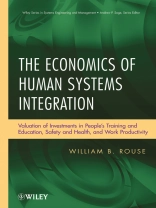Fundamental Economic Principles, Methods, and Tools for
Addressing Human Systems Integration Issues and Tradeoffs
Human Systems Integration (HSI) is a new and fundamental
integrating discipline designed to help move business and
engineering cultures toward more human-centered systems.
Integrating consideration of human abilities, limitations, and
preferences into engineering systems yields important cost and
performance benefits that otherwise would not have been
accomplished. In order for this new discipline to be effective,
however, a cultural change–starting with organizational
leadership–is often necessary.
The Economics of Human Systems Integration explains the
difficulties underlying valuation of investments in people’s
training and education, safety and health, and work productivity.
It provides an overview of how the field of economics addresses
these difficulties, focusing on human issues associated with
design, development, production, operations, maintenance, and
sustainment of complex systems.
The set of thought leaders recruited as contributors to this
volume collectively provides a compelling set of data and
principles for assessing the economic value of investing in people,
not just in general but in specific investment situations. The
early chapters provide the contexts for HSI and investment
analysis, illustrating the enormous difference context makes in how
issues are best framed and analyzed. A host of practical methods
and tools for investment valuation are then presented. Provided
are:
* A variety of real-world applications of economic analysis
ranging from military acquisition and automotive investment to
healthcare and high-tech investments in general, in both the U.S.
and abroad
* A range of economics-based methods and tools for cost analysis,
cost-benefit analysis, and investment analysis, as well as sources
of data for performing such analyses
* Differing perspectives on economic decision-making, including a
range of private sector points of view, as well as government and
regulatory perspectives
In addition, five real-world case studies illustrate how such
valuations have been done and their major impacts on investment
decisions. HSI professionals, systems engineers, and finance
professionals who address investment analysis will appreciate the
wide range of methods and real-life applications; senior
undergraduates and masters-level graduate students will find this
to be an excellent textbook that provides theory and supports
practice.
Table des matières
Preface.
Contributors.
PART I INTRODUCTION.
1. Introduction (William B. Rouse).
2. Industry and Commercial Context (William B.
Rouse).
3. Government and Defense Context (William B. Rouse
and Douglas A. Bodner).
PART II ECONOMICS OVERVIEW.
4. Human Capital Economics (William B. Rouse).
5. Labor Economics (Nachum Sicherman).
6. Defense Economics (Keith Hartley).
7. Engineering Economics (William B. Rouse).
PART III MODELS, METHODS, AND TOOLS.
8. Parametric Cost Estimation for Human Systems Integration
(Ricardo Valerdi and Kevin Liu).
9. A Spreadsheet-Based Tool for Simple Cost-Benefit
Analyses of HSI Contributions During Software Application
Development (Deborah J. Mayhew).
10. Multistage Real Options (Michael J.
Pennock).
11. Organizational Simulation for Economic Assessment
(Douglas A. Bodner).
PART IV CASE STUDIES.
12. HSI Practices in Program Management: Case Studies of
Aegis (Aruna Apte).
13. The Economic Impact of Integrating Ergonomics within an
Automotive Production Facility (W. Gary Allread and William
S. Marras).
14. How Behavioral and Biometric Health Risk Factors Can
Predict Medical and Productivity Costs for Employers (Ron Z.
Goetzel, Enid Chung Roemer, Maryam Tabrizi, Rivka Liss-Levinson,
and Daniel K. Samoly).
15. Options for Surveillance and Reconnaissance
(William B. Rouse).
16. Governing Opportunism in International Armaments
Collaboration: The Role of Trust (Ethan B.
Kapstein).
Index.
A propos de l’auteur
William B. Rouse is Executive Director of the Tennenbaum Institute at the Georgia Institute of Technology. He is also a professor in the College of Computing and School of Industrial and Systems Engineering. Rouse’s earlier positions include chair of the School of Industrial and Systems Engineering, CEO of two innovative software companies–Enterprise Support Systems and Search Technology–and faculty positions at Georgia Tech, University of Illinois, Delft University of Technology, and Tufts University.












